-
SEO benchmarks are reference metrics that are able to highlight strengths and weaknesses in your website’s performance, allowing you to understand its progress and make informed decisions. They also help prioritize efforts, especially when comparing performance to competitors, offering insights into areas for improvement.
-
Start by setting realistic goals, defining key metrics and conducting a thorough website analysis. Plus, monitoring your competitors’ strategies is key to improving SEO performance.
-
Important benchmarks include organic traffic, keyword rankings, impressions, bounce rate, average engagement time, conversion rates, number of referring domains and backlinks, share of voice, and Domain Trust score.
Achieving SEO success requires strategic planning and continuous optimization. One key aspect of this process is SEO benchmarking, which helps you track and measure your performance in any campaign.
In this guide, we’ll walk you through the steps to effectively benchmark your SEO and explore which SEO benchmarks matter and why.
Disclaimer: This article was initially drafted using SE Ranking’s AI Writer. However, some parts of the text were written from scratch and the content has undergone thorough revisions, editing, and fact-checking by human editors and subject matter experts to ensure accuracy.
What are SEO benchmarks?
SEO benchmarks are essential metrics that measure your website’s performance on search engines. By establishing these benchmarks, you can evaluate how your website stacks up against industry standards and competitors. Benchmarking your SEO performance means setting specific, measurable targets to track your progress.
Note: While KPIs and benchmarks are related, they serve different purposes. KPIs measure what you are trying to achieve, while benchmarks tell you how far you’ve come and what’s needed to reach your objectives. For example, your KPI might be to increase organic traffic by 15%, and your benchmark could be last year’s traffic levels. By regularly comparing your KPIs to benchmarks, you can adjust your strategy for better results.
Why are SEO benchmarks important?
Understanding what are SEO benchmarks and how to work with them is key to a successful SEO strategy. These benchmarks serve as the pulse of your digital marketing efforts. By tracking them, you’ll know whether your SEO campaigns are effective or need tweaking.
- SEO benchmarks lay the foundation for prioritizing tasks and focusing on areas that require immediate attention. For example, if your keyword rankings are not improving despite excellent content, the problem might be technical SEO issues. Fix these, and you could see a significant boost in performance.
- Moreover, benchmarking against your competitors provides valuable insights. For instance, if your competitor’s website has a lower bounce rate, it might be worth analyzing their site to understand why their user engagement is better.
- Benchmarks also help you measure your progress over time. For instance, you can compare the current month’s organic traffic with that of the previous month. This will help you understand whether your SEO strategies are making a difference or not.
In summary, SEO benchmarks are your guideposts. They ensure you stay on the right path, helping you make informed decisions and adjustments to your SEO strategy.
How to benchmark your SEO?
Benchmarking your SEO performance starts with understanding what to measure. Here’s a quick guide.
1. Setting realistic goals and targets
The goals will help you choose key SEO benchmarks to analyze, compare and monitor.
For example, if your current website’s load time is slow, you might set a goal to improve it within the next three months. So, your benchmark should be your website’s load time.
Setting realistic goals and targets ensures you have attainable milestones to work towards. These goals should be based on thorough competitor analysis and industry standards. Practical benchmarks backed by data provide a clear pathway to success.
2. Defining what is to be measured or evaluated
This is not just about selecting a few easy-to-track metrics but identifying crucial SEO elements that can provide actionable insights. These often include rankings, traffic, conversions, bounce rate, etc. We will describe the key benchmarks in the next section.
High-quality benchmarking relies on the depth and breadth of the data you choose to analyze.
It’s crucial to have a tool that provides you with reliable data. SE Ranking offers its own crawlers, unique algorithms, and ever-growing keyword databases (5.3 billion keywords and 188 geo databases) to meet the needs of SEO professionals.
When defining these metrics, consider their impact on your overall SEO strategy. For instance, monitoring rankings helps you understand your position in the SERPs for various keywords. While traffic measures the volume of visitors to your site, conversions indicate how many of those visitors are taking desired actions like making a purchase or filling out a form.
Focus on the metrics that matter most to you, making sure your data is accurate and reliable. Choose the key metrics that give you a clear view of your performance without any extra clutter. If something seems off, you can always dig deeper to find out what’s going on.
3. Analyzing your website
Conducting an in-depth analysis of your website is crucial. This assessment will reveal how well your site is optimized and which benchmarks need your attention. Your internal SEO audit will uncover:
- Strengths: What’s working well. Maintain those practices to enjoy continuous benefits.
- Weaknesses: Areas that need improvement. Maybe your content is poorly optimized, and lacks internal links.
- Threats: Factors that might be harming your SEO efforts. Ensure there’s no duplicate content, keyword stuffing, or broken links.
4. Identifying your competitor’s strategy
You’re not alone in the race. Understanding your competition is just as important. Conducting an SEO analysis of competitors can reveal their strengths and weaknesses, providing valuable insights into their strategies. This will help you compare your benchmarks with the situation on the market as a whole and understand what you need to strive for.
Regular competitor analysis ensures your SEO efforts remain competitive. By studying their best practices, you can adopt effective tactics, tailor your strategy, and avoid their pitfalls. This continuous benchmarking keeps you ahead in the SEO game.
5. Defining KPIs
As described above, KPIs and benchmarks often work together. They are essential metrics that define success for your SEO efforts.
KPIs such as organic traffic, keyword rankings, or conversion rates provide concrete data points that serve as a baseline for measuring SEO success. These baselines allow you to compare your current performance to previous periods, helping you track progress and improvements over time.
By tracking KPIs over time, you can see how effective your SEO strategies are in achieving specific goals, such as boosting organic search traffic or improving keyword rankings. The comparison of these metrics with past benchmarks enables you to identify areas where your strategy is working or needs adjustment.
6. Regularly monitoring
Regular monitoring is essential to ensure your SEO strategy stays on track. Use automated tools to simplify the tracking of benchmarks. Regular reviews reveal trends and inform adjustments, helping you achieve long-term SEO success.
Tools like Google Analytics and Google Search Console can provide valuable insights into your website’s performance. Set up automated reports to track critical metrics like organic traffic, bounce rates, and conversion rates. Regularly review these reports to identify trends and make data-driven decisions.
Continuous monitoring also helps you stay ahead of the competition. By keeping an eye on competitors’ performance, you can quickly identify new opportunities and threats. Use tools like SE Ranking to track your competitors’ keyword rankings, backlink profiles, and site performance.
Below, you’ll see how to use them.
Key benchmarks for achieving SEO success
Establishing the right benchmarks is crucial for SEO success. Here are the key metrics you should focus on:
Keyword rankings
Keyword rankings show how well your website ranks for target keywords. Monitoring keyword rankings helps identify successful and underperforming keywords. Higher rankings often translate to more traffic.
Benchmarking individual keyword positions enables you to track progress and set goals for important keywords. For example, if your website is currently ranked #10 for “digital marketing strategies,” you can use that as a benchmark to aim for improvement.
Use tools like SE Ranking’s Rank Tracker to monitor your keyword rankings. This tool provides insights into your website’s performance for specific keywords, including metrics such as visibility, estimated traffic, average keyword position, SERP features, and more. Additionally, it allows you to monitor changes in your keyword rankings over time.
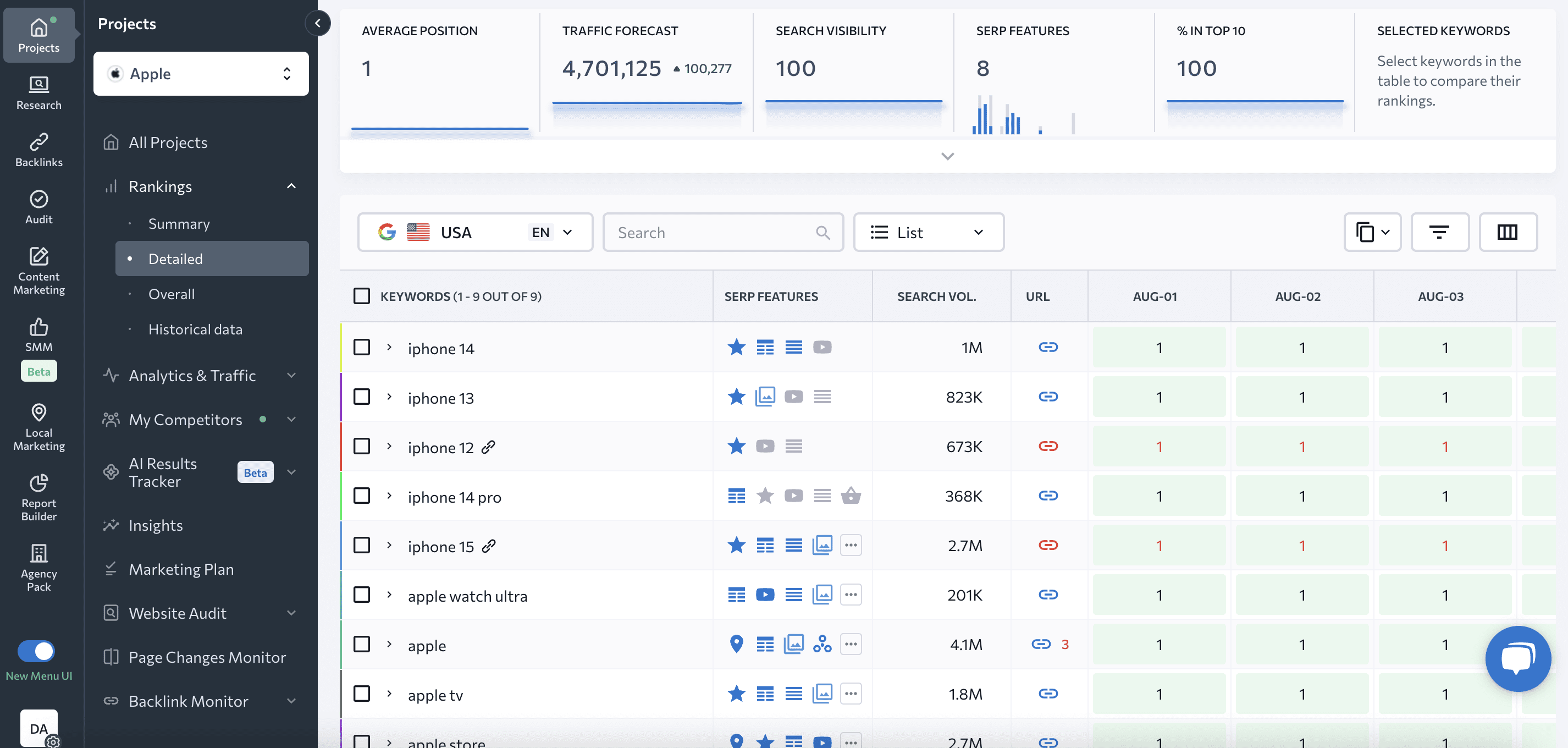
Organic traffic
Organic traffic measures the number of visitors who come to your site from search engines.
Higher organic traffic generally indicates better visibility and effective SEO efforts. Consistent growth in organic traffic demonstrates that your SEO strategies are working.
This benchmark provides valuable insights into your audience’s behavior. For example, if you notice a spike in traffic, you can analyze what caused it. Maybe a particular blog post went viral, or a recent SEO update improved your rankings. Understanding these trends helps you replicate success and avoid pitfalls.
To establish and track organic traffic, you can use tools like Google Analytics. Go to the Acquisition report and select the Traffic acquisition section, then look for the Organic Search row. Here, you’ll find all the data on traffic generated through SEO.
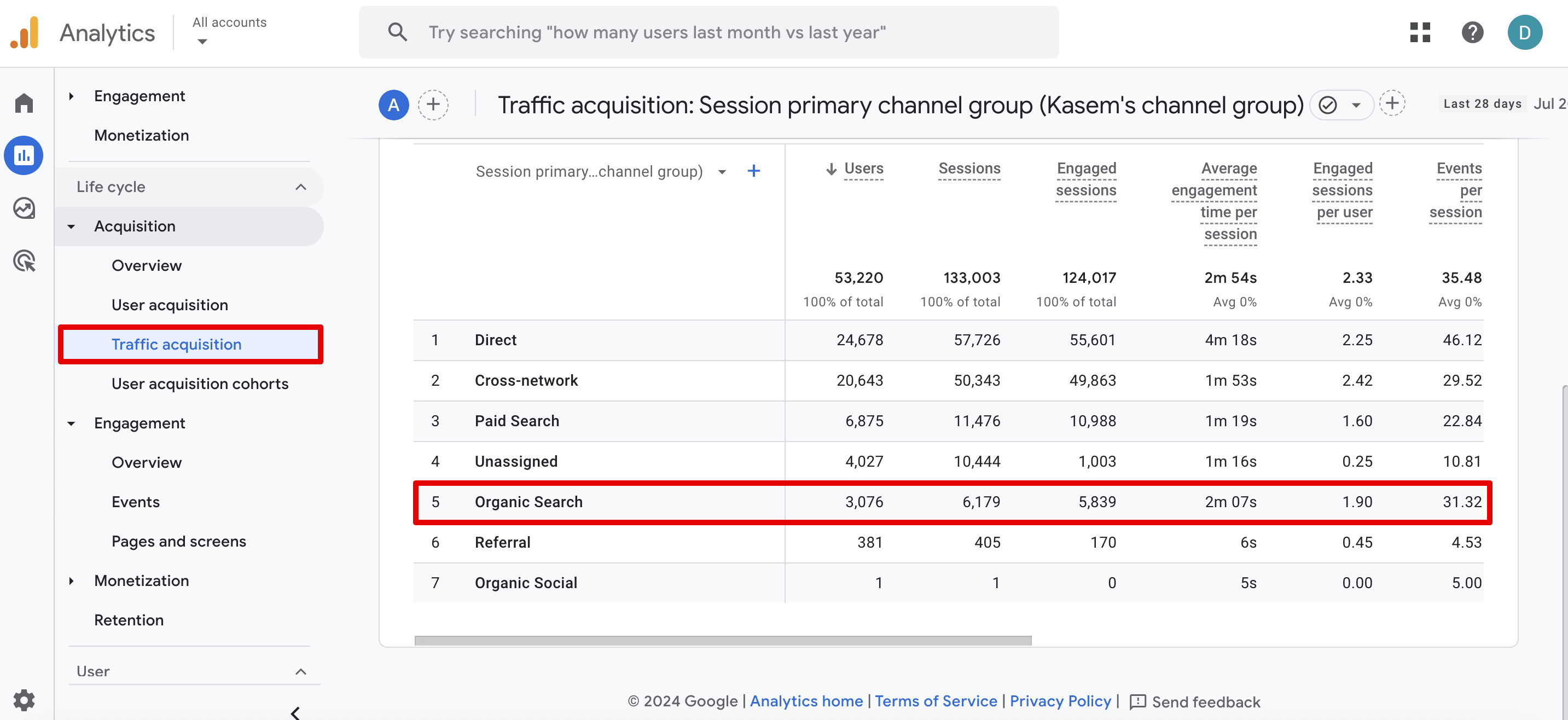
You can also see a graph comparing the organic traffic trends for a defined period.
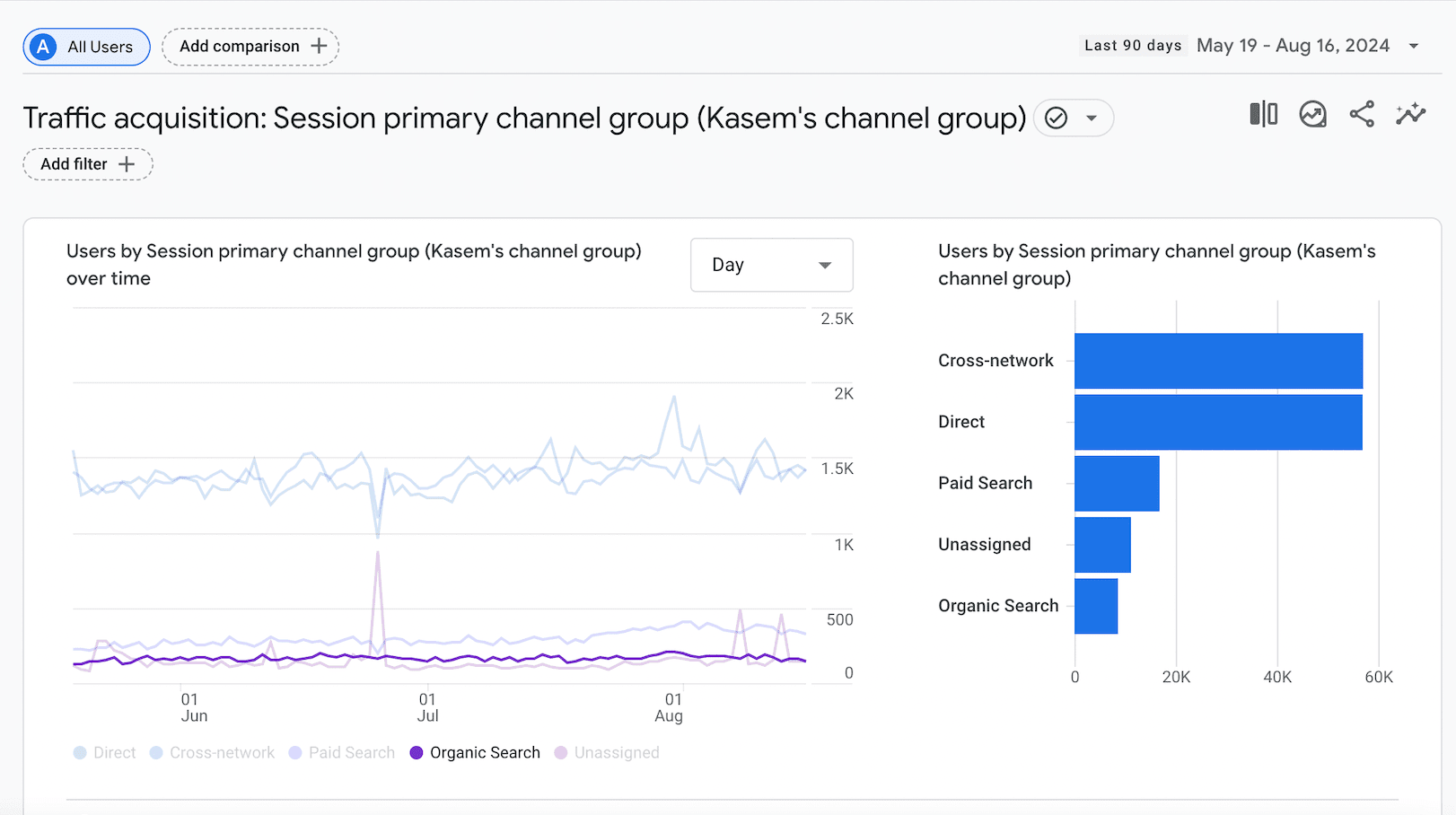
Impressions and clicks
Impressions count the number of times your site appears in search results. Clicks show how often users visit your site from search results. High impressions but low clicks suggest a need for better meta titles and descriptions to encourage more clicks.
For instance, if your website shows up in search results for “best coffee shops in Seattle,” with 500 people seeing it (impressions) and only 20 clicking on it (clicks), your CTR would be 4%.
Use Google Search Console to track impressions and clicks. The tool provides detailed insights into how often your site appears in search results and how many users click on your site. Go to the Search Results section in the Performance report. You’ll see a graph displaying your website’s total impressions and clicks over a defined period.
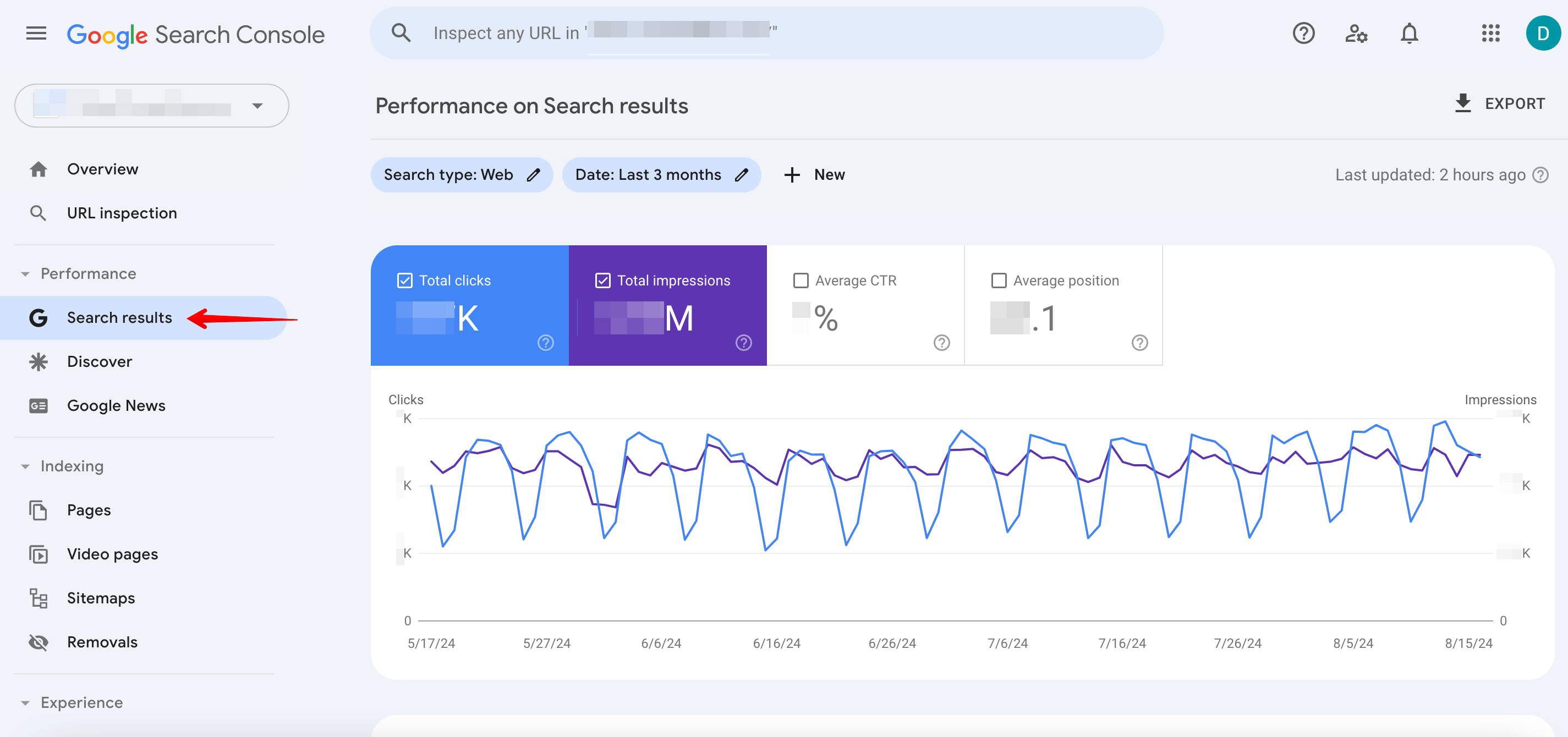
You can also view clicks and impressions for each keyword and page individually.
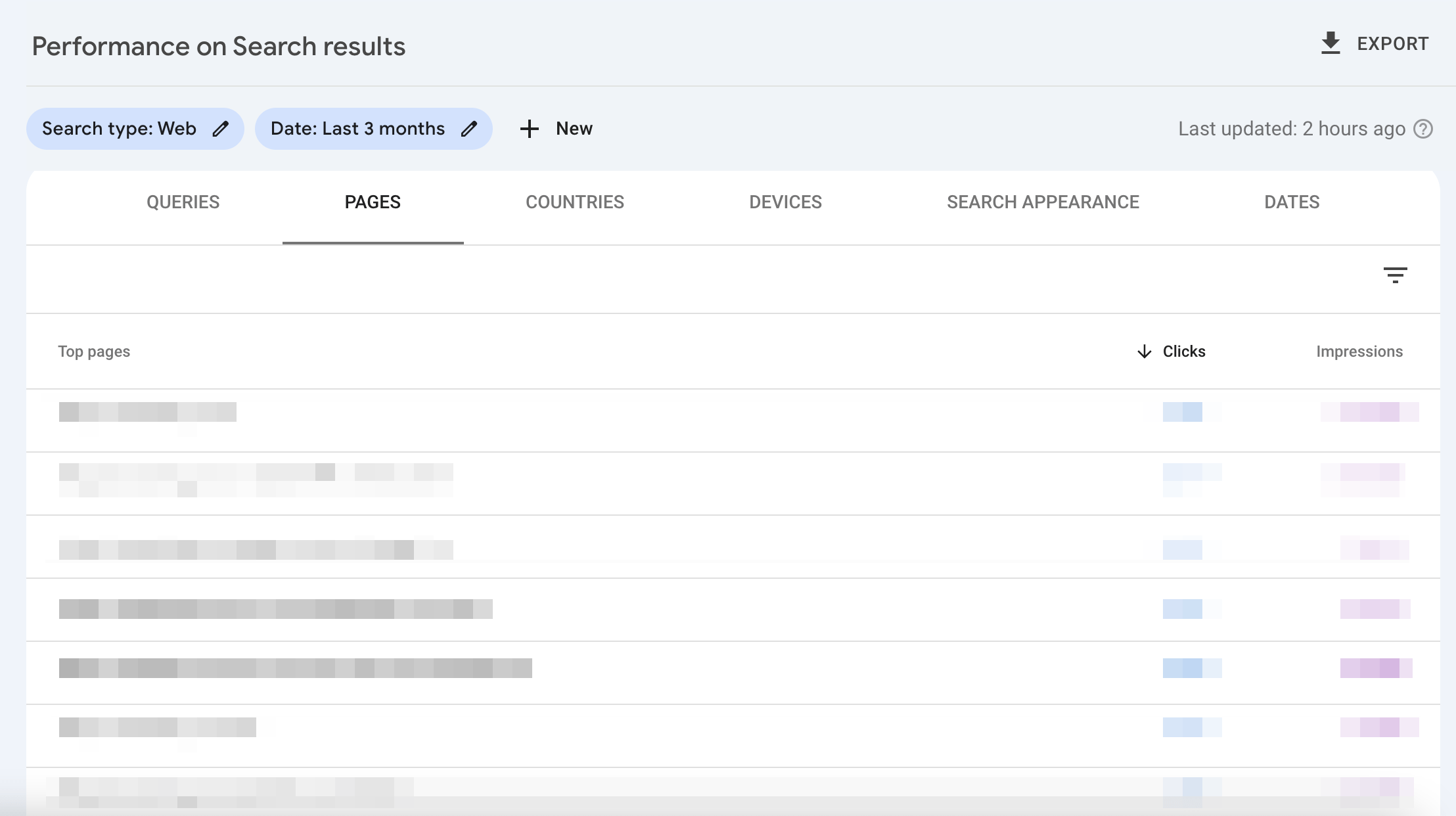
This information allows you to benchmark your website’s SEO performance against competitors in search results.
Bounce rate
Bounce rate measures the percentage of visitors who leave without interacting with your site. A high bounce rate indicates user dissatisfaction or irrelevant content. Low bounce rates often mean higher engagement.
Use tools like Google Analytics to track your site’s bounce rate. To view this metric in GA4, you’ll need to set it up. We’ve outlined the step-by-step process here.
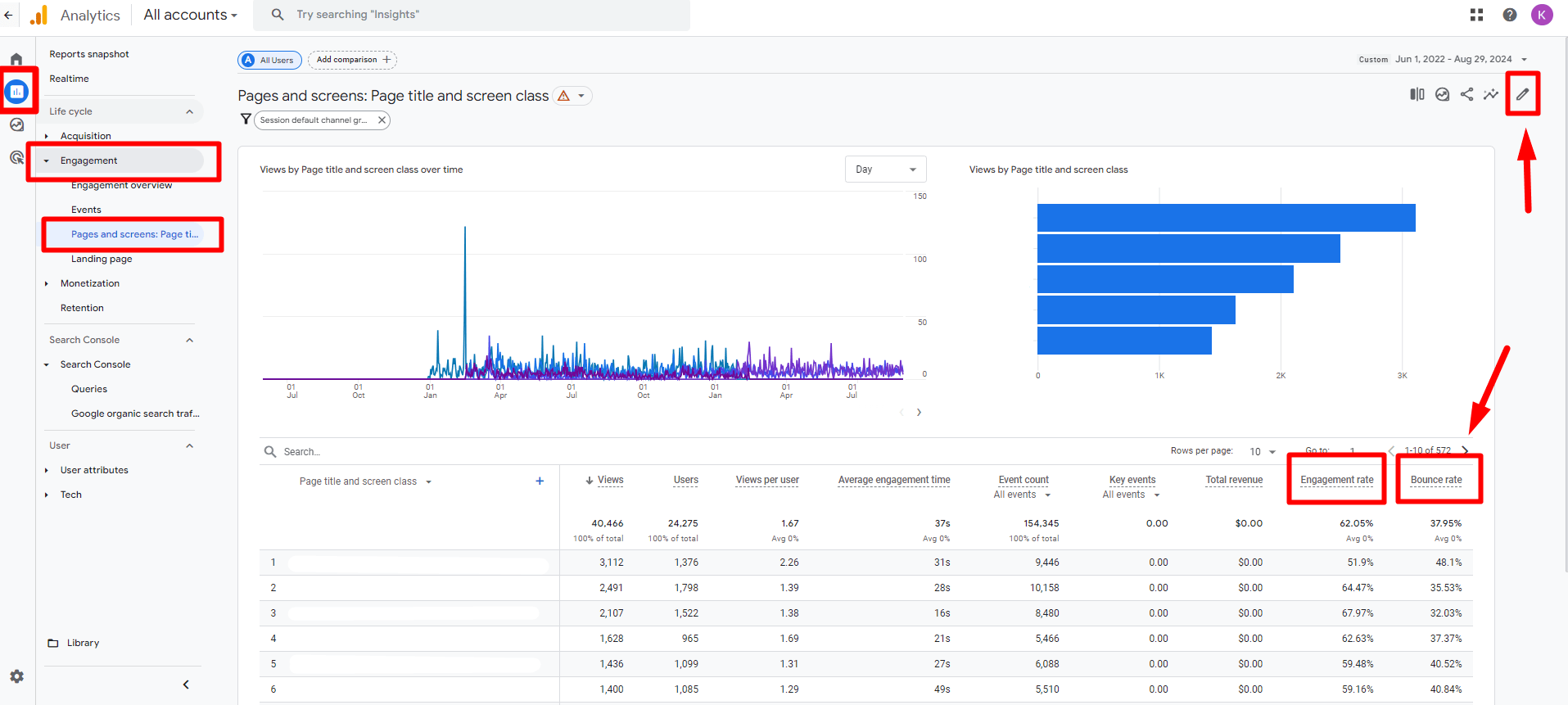
By benchmarking your pages with high bounce rates, you can focus on improving them by creating valuable, relevant content and enhancing the user experience.
Average engagement time
Average engagement time reflects how long visitors stay on your site. Tracking engagement helps identify popular content. Moreover, improving engagement can lead to better conversion rates.
Use tools like Google Analytics to track this benchmark. Overall average engagement time is listed on the main dashboard.

For a detailed breakdown, go to Engagement ▶️ Pages and Screens.
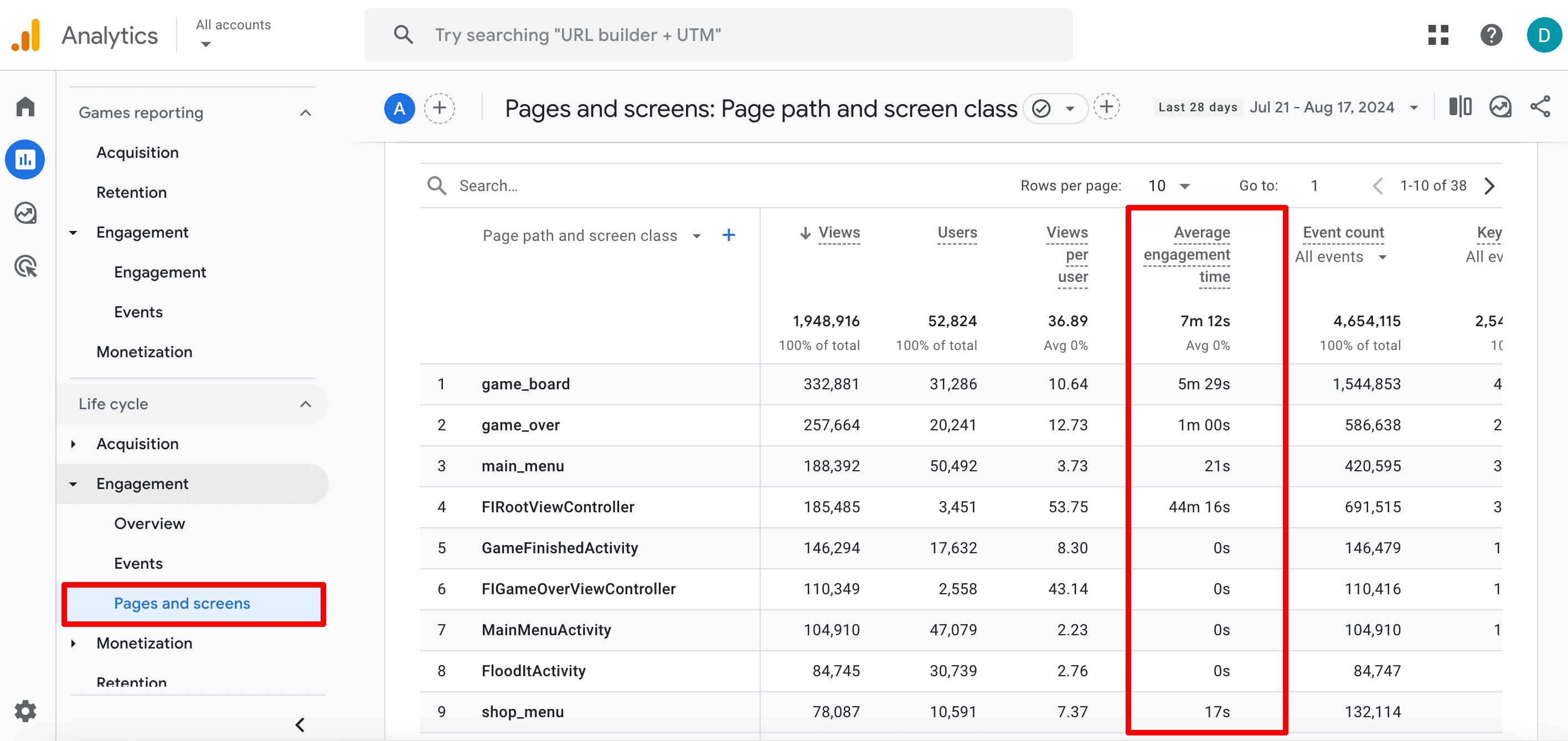
Improving this benchmark often involves creating valuable, relevant content that meets your audience’s needs. Incorporate multimedia elements like images, videos, and infographics to make your content more engaging. Encourage interaction through comments, social shares, and other methods of engagement.
Conversion rate
Conversion rate measures the percentage of visitors who complete desired actions (e.g., purchases, sign-ups, or installs). Higher conversion rates indicate effective SEO and user experience.
Use tools like Google Analytics to track your site’s conversion rate.
To track conversions driven by SEO, go to Acquisition ▶️ User Acquisition in GA4. In the Key events column, select the desired action, then review the Organic Search row.
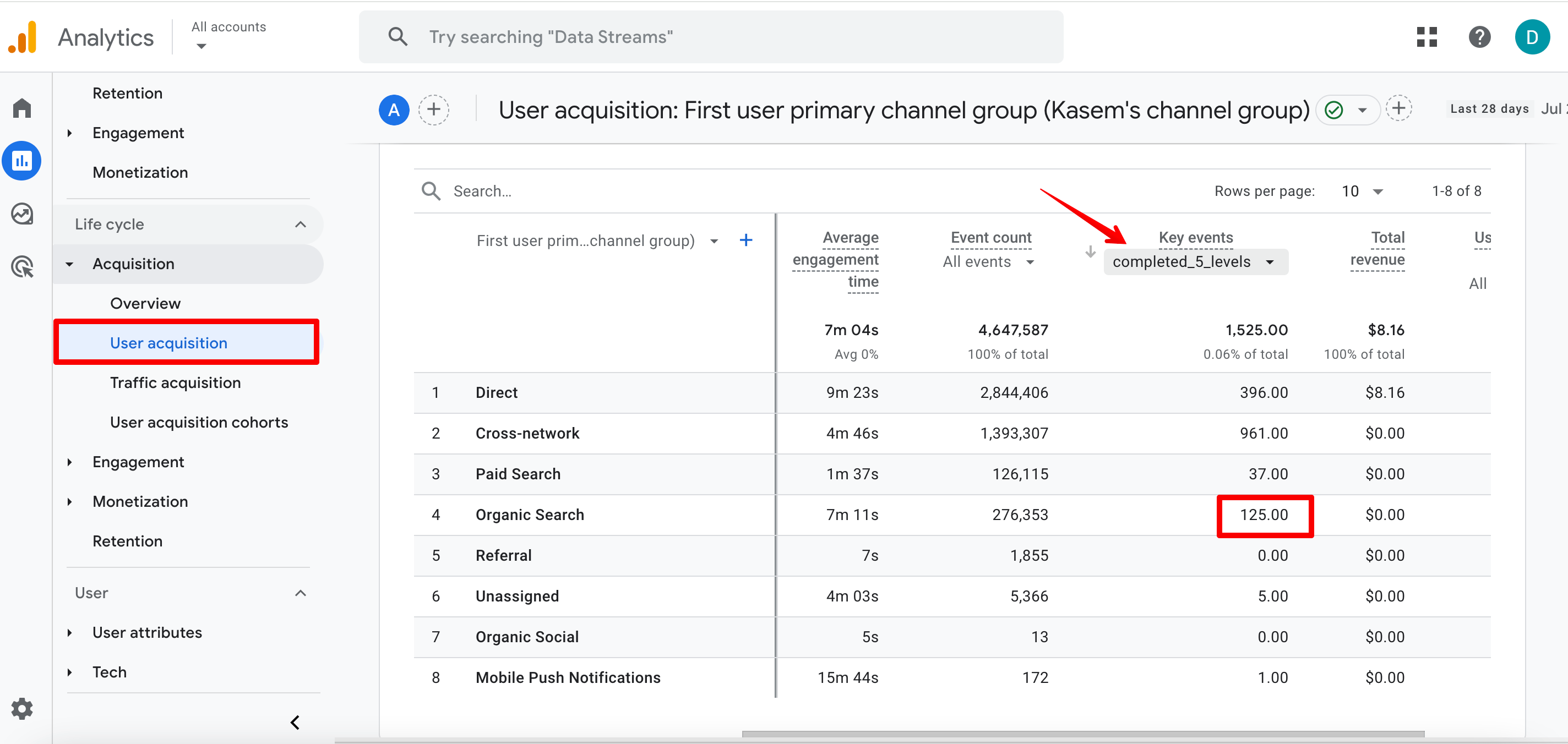
This benchmark helps determine whether you need to optimize your overall SEO strategy.
The number of referring domains and backlinks
The number of unique websites linking to your site, along with the overall number of links from other websites, are important benchmarks. Search engines like Google view them as endorsements from external sources. So, benchmarking the number of backlinks and referring domains allows you to analyze and build your website’s authority and monitor its growth over time.
Use tools like SE Ranking’s Backlink Checker to track your site’s referring domains and backlinks.

You can also analyze referring domains and backlinks in detail within the Referring Domains and Backlinks sections.
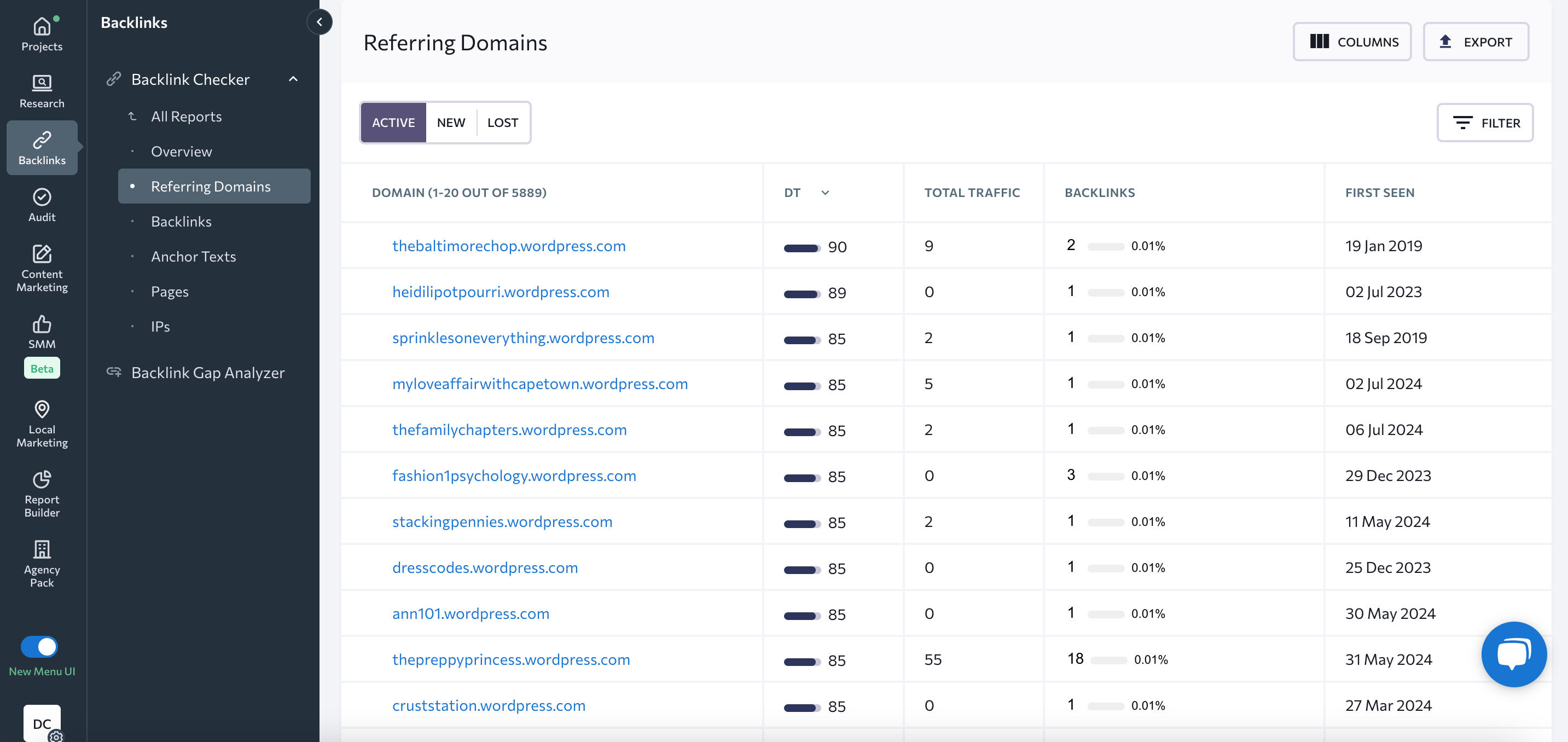
Domain Trust score
Domain Trust score predicts your site’s ranking ability. Higher scores translate to better search engine performance. Tracking domain authority helps gauge overall SEO effectiveness.
Benchmarking Domain Trust is a common practice, especially for agencies that work with clients who may not fully understand SEO. It’s simpler to communicate that a rising DR indicates overall improvement.
Use tools like SE Ranking’s Backlink Checker to track your site’s domain authority score. Analyze the data to identify trends and develop strategies to improve your site’s domain authority.
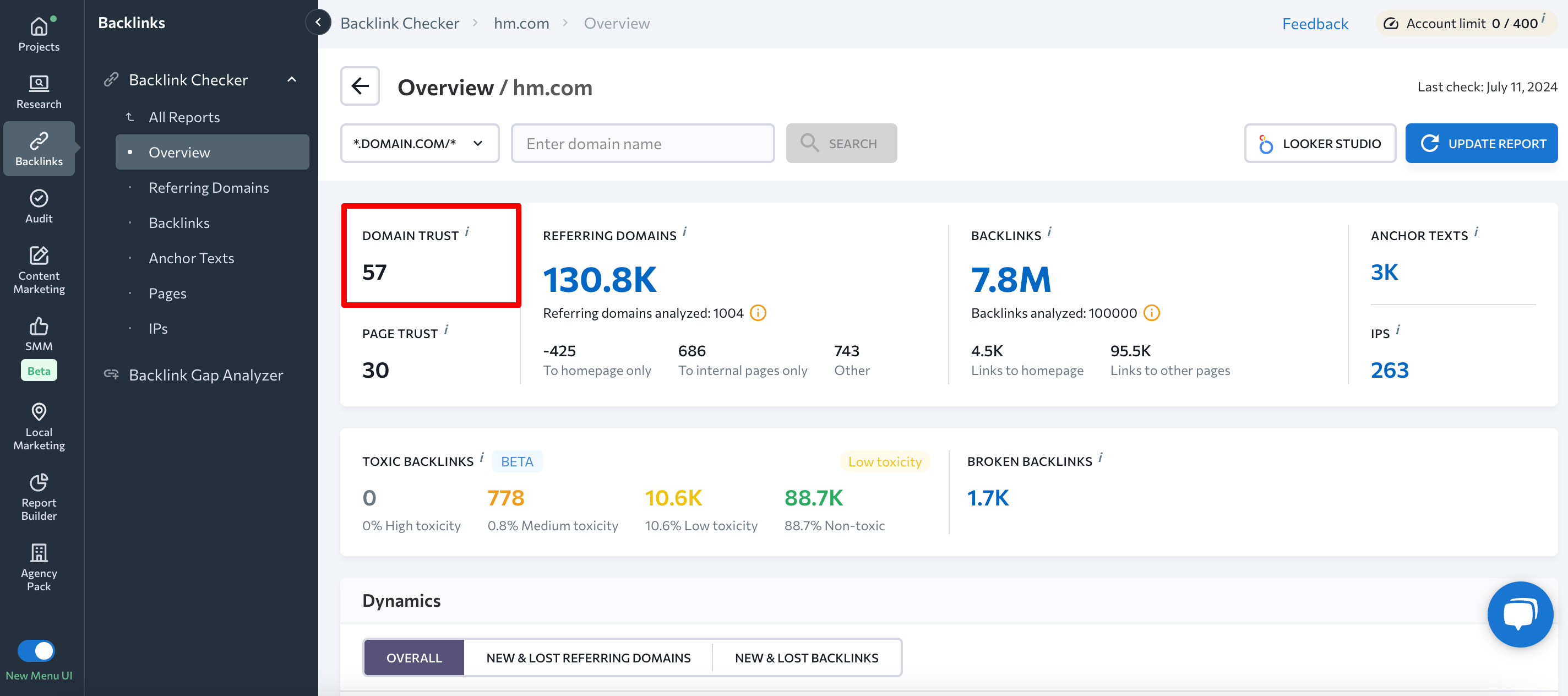
Share of voice
Share of voice measures your brand’s voice strength compared to competitors. A higher share of voice indicates a stronger market presence — essentially showing the share of traffic your brand captures on the SERPs.
To analyze this data, use SE Ranking’s Share of Voice feature.
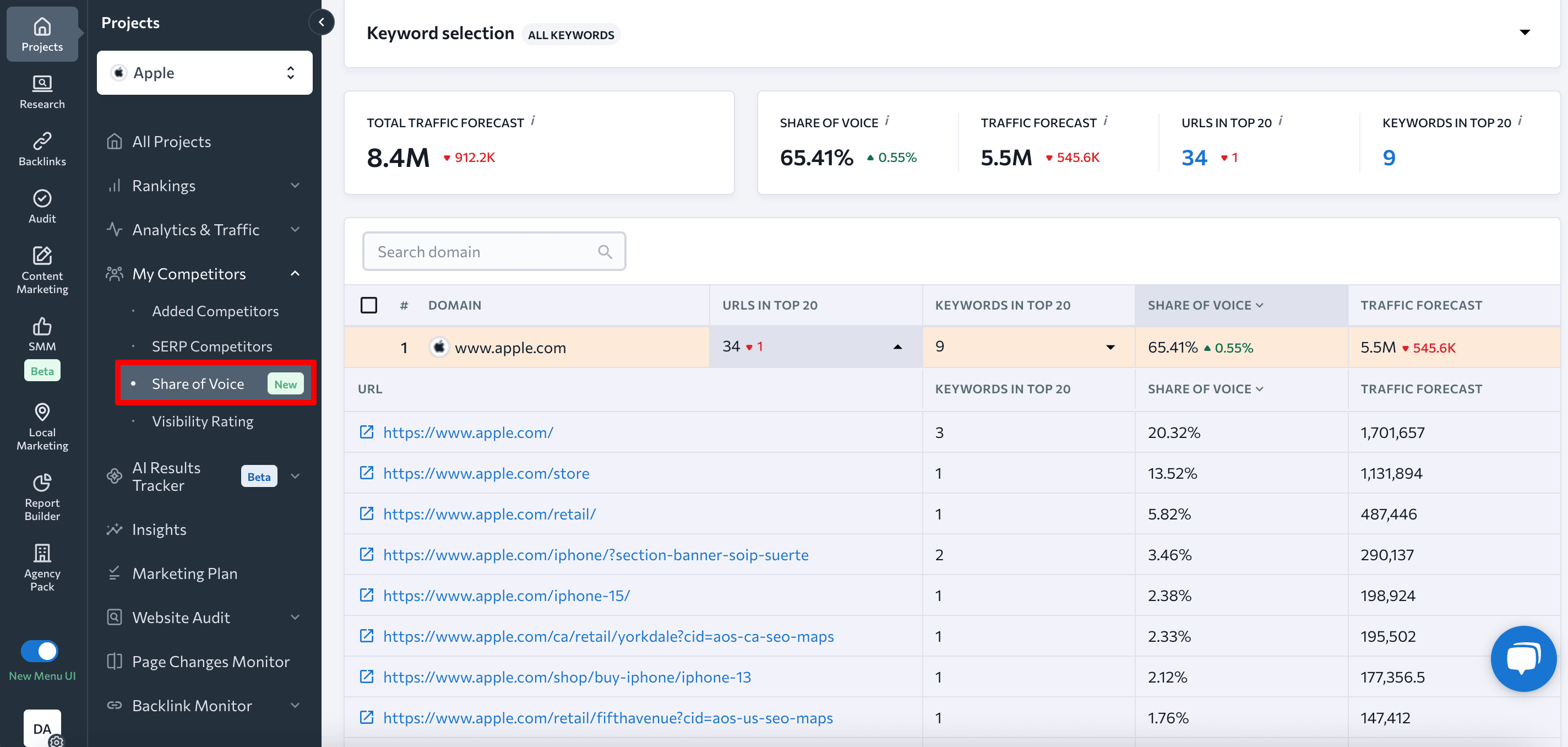
Having a strong share of voice amplifies your brand’s influence, which is a key goal of digital marketing.
Final thoughts
Benchmarking key metrics helps achieve sustainable SEO success for your business.
By monitoring key metrics like organic traffic, keyword rankings, and conversion rates, you can make data-driven decisions and achieve long-term success. Regularly compare your performance with competitors and industry standards to stay ahead of the curve.
Remember, SEO is a marathon, not a sprint. Consistent effort and regular adjustments are essential for success. Benchmarking your SEO performance is just the first step. Stay committed, keep learning, and you’ll see the results.
